Offshore Geothermal Energy Perspectives: Hotspots and Challenges
Abstract
1. Introduction
2. Method
3. Results
3.1. Typical Offshore Geothermal Resources
3.2. Literature and Patent Survey Analysis
3.3. Geothermal Energy Recovery from Low Temperature in Oil and Gas Fields
3.4. Challenges and Limitations
4. Offshore Geothermal Opportunities
4.1. Potential Areas for Petroleum Repurpose
4.2. Potential Areas in Volcanic Geological Setting
4.3. Petroleum and Offshore Geothermal Exploration Subsurface Technology Synergy
5. Discussion and Challenges
6. Final Remarks
Author Contributions
Funding
Data Availability Statement
Acknowledgments
Conflicts of Interest
Abbreviations
| eq | Equivalent |
| Gt | Giga Tons |
| GW | Giga Watt |
| MW | Mega Watt |
| MWe | Mega Watt Electric |
| mW/m2 | Milliwatt per Square Meter |
References
- IRENA; IGA. Global Geothermal Market and Technology Assessment; International Renewable Energy Agency: Abu Dhabi, United Arab Emirates; International Geothermal Association: The Hague, The Netherlands, 2023.
- IEA. World Energy Outlook 2024; IEA: Paris, France, 2024.
- Stober, I.; Bucher, K. Geothermal Energy: From Theoretical Models to Exploration and Development; Springer: Berlin/Heidelberg, Germany, 2013; ISBN 978-3-642-13352-7. [Google Scholar]
- Karason, B.; Gudjonsdottir, M.S.; Valdimarsson, P.; Thorolfsson, G. Utilization of Offshore Geothermal Resources for Power. In Proceedings of the 38th Workshop on Geothermal Reservoir Engineering, Stanford, CA, USA, 11–13 February 2013. [Google Scholar]
- Pilko, R.M.; Rita Hart-Wagoner, N.; Energy Partners, B.; Van Horn, A.J.; Scherer, J.A. Repurposing Oil & Gas Wells and Drilling Operations for Geothermal Energy Production. In Proceedings of the Offshore Technology Conference, Houston, TX, USA, 16–19 August 2021. [Google Scholar] [CrossRef]
- Rashid, F.; Singh, D. Energy Transitioning Journey of Decommissioning Oil and Gas Wells: A Geothermal Perspective. Mar. Pet. Geol. 2024, 164, 106848. [Google Scholar] [CrossRef]
- Shawky, A.; El-Anbaawy, M.I.; Soliman, R.; Shaheen, E.N.; Osman, O.A.; Hafiez, H.E.A.; Shallaly, N.A. Utilization of Abandoned Oil Well Logs and Seismic Data for Modeling and Assessing Deep Geothermal Energy Resources: A Case Study. Sci. Total Environ. 2024, 946, 174283. [Google Scholar] [CrossRef] [PubMed]
- Robinson, R.; Englemann, G.; Saterlee, K. Repurposing Gulf of Mexico Oil and Gas Facilities for the Blue Economy. In Proceedings of the Offshore Technology Conference, Houston, TX, USA, 2–5 May 2022. [Google Scholar] [CrossRef]
- Batir, J.F.; Gentry, E.N.; Boak, J.; McDowell, B.; Soroush, H. New Life for Old Offshore Platforms—Where Is Geothermal an Option? In Proceedings of the Offshore Technology Conference, Houston, TX, USA, 2–5 May 2022. [Google Scholar] [CrossRef]
- Batir, J.; Gentry, E.; Soroush, H. Review of Offshore Geothermal Projects: Past Projects and Current Ideas. In Proceedings of the Offshore Technology Conference, Houston, TX, USA, 6–9 April 2024. [Google Scholar] [CrossRef]
- IPCC. IPCC a Climate Change Mitigation of Climate Change. Working Group III. Contribution to the Sixth Assessment Report; IPCC: Geneva, Switzerland, 2022. [CrossRef]
- United Nation Climate Change. Outcome of the First Global Stocktake. In Proceedings of the COP 28—Conference of the Parties, Abu Dhabi, United Arab Emirates, 30 November–13 December 2023. [Google Scholar]
- United Nation Climate Change. Summary of Global Climate Action at COP 29. In Proceedings of the COP 29—Conference of the Parties, Bakur, Azerbaijan, 11–22 November 2024. [Google Scholar]
- The World Bank—ESMAP. Greenhouse Gases from Geothermal Power Production; The World Bank—ESMAP: Washington, DC, USA, 2016. Available online: http://documents.worldbank.org/curated/en/550871468184785413 (accessed on 27 April 2025).
- Amponsah, N.Y.; Troldborg, M.; Kington, B.; Aalders, I.; Hough, R.L. Greenhouse Gas Emissions from Renewable Energy Sources: A Review of Lifecycle Considerations. Renew. Sustain. Energy Rev. 2014, 39, 461–475. [Google Scholar] [CrossRef]
- Loschetter, A.; Kervévan, C.; Stead, R.; Le Guénan, T.; Dezayes, C.; Clarke, N. Integrating Geothermal Energy and Carbon Capture and Storage Technologies: A Review. Renew. Sustain. Energy Rev. 2025, 210, 115179. [Google Scholar] [CrossRef]
- IEA. Technology Roadmap: Geothermal Heat and Power; IEA: Paris, France, 2011.
- IEA. The Future of Geothermal Energy; IEA: Paris, France, 2024.
- Gutiérrez-Negrín, L.C.A. Evolution of Worldwide Geothermal Power 2020–2023. Geotherm. Energy 2024, 12, 14. [Google Scholar] [CrossRef]
- Mines, G.; Richard, C.; Nathwani, J.; Hanson, H.; Wood, R. Geothermal Plant Capacity Factors. In Proceedings of the 40th Workshop on Geothermal Reservoir Engineering, Stanford, CA, USA, 26–28 January 2015. [Google Scholar]
- Global Energy Observatory. Global Power Plant Database; Global Energy Observatory: Los Alamos, NM, USA, 2015; Available online: http://globalenergyobservatory.org (accessed on 27 April 2025).
- Global Energy Monitor. Global Geothermal Power Tracker. Available online: https://globalenergymonitor.org/projects/global-geothermal-power-tracker/ (accessed on 11 January 2025).
- Pedamallu, L.; Rodrigues, N.; Hiriart, G.; Cruz, J. Economics of Offshore Geothermal Energy and Mineral Extraction. In Proceedings of the European Geothermal Congress, European Geothermal Energy Council, Den Haag, The Netherlands, 11–14 June 2019; pp. 11–14. [Google Scholar]
- Bolton, R.; Crossley, R.; Fowler, A.; Peter-Borie, M.; Drumm, E.; Williams, M. Offshore Geothermal: A Major Resource for a Stressed Planet. In Proceedings of the International Petroleum Technology Conference, IPTC 2024, Dhahran, Saudi Arabia, 12–14 January 2024. [Google Scholar]
- Prabowo, T.R.; Fauziyyah, F.; Suryantini; Bronto, S. A New Idea: The Possibilities of Offshore Geothermal System in Indonesia Marine Volcanoes. 6th ITB International Geothermal Workshop, Bandung, Indonesia. In IOP Conference Series: Earth and Environmental Science; Institute of Physics Publishing: Bristol, UK, 2018; Volume 103, p. 011001. [Google Scholar] [CrossRef]
- Sircar, A.; Bist, N.; Yadav, K. A Comprehensive Review on Exploration and Exploitation of Offshore Geothermal Energy. Mar. Syst. Ocean. Technol. 2023, 17, 135–146. [Google Scholar] [CrossRef]
- SCOPUS. SCOPUS—Abstract and Citation Database. Available online: https://www.scopus.com/home.uri (accessed on 4 February 2025).
- The United States Patent and Trademark Office. USPTO. Available online: https://www.uspto.gov (accessed on 9 February 2025).
- The European Patent Office (EPO). Available online: https://worldwide.espacenet.com/ (accessed on 9 February 2025).
- The International Heat Flow Commission (IHFC). Global Heat Flow Database. Available online: https://ihfc-iugg.org/products/global-heat-flow-database/data (accessed on 13 March 2025).
- Kolawole, F.; Evenick, J.C. Global Distribution of Geothermal Gradients in Sedimentary Basins. Geosci. Front. 2023, 14, 101685. [Google Scholar] [CrossRef]
- ESRI. ESRI Physical. Available online: https://server.arcgisonline.com/ArcGIS/rest/services/World_Physical_Map/MapServer/tile/{z}/{y}/{x} (accessed on 31 March 2025).
- Nash, S.S.; Friend, P.L.; Brommer, M. A Fully Integrated and Updated Geothermal Gradient Atlas of the World. In Proceedings of the Offshore Technology Conference, Houston, TX, USA, 2–5 May 2022. [Google Scholar]
- Elders, W.A.; Moore, J.N. Geology of Geothermal Resources. In Geothermal Power Generation: Developments and Innovation; Elsevier Inc.: Amsterdam, The Netherlands, 2016; pp. 7–32. ISBN 9780081003442. [Google Scholar]
- Elders, W.A.; Guðmundur, Ó. Friðleifsson; Bjarni Pálsson. Iceland Deep Drilling Project: The First Well IDDP-1, Drilled into Magma. Geothermics 2014, 1, 1–128. [Google Scholar] [CrossRef]
- Scott, S.; Eggertsson, H.; Stefánsson, A. Enhancing Geothermal Reservoir Models with Discrete Magmatic Heat Sources. In Proceedings of the 50th Workshop on Geothermal Reservoir Engineering, Stanford, CA, USA, 10–12 February 2025; Volume 50. [Google Scholar]
- Toralde, J. Offshore Geothermal Energy Utilization: An Idea Whose Time Has Come? In Proceedings of the Offshore Technology Conference Asia, Kuala Lumpur, Malaysia, 25–28 March 2014. [Google Scholar] [CrossRef]
- Al-Ghouti, M.A.; Al-Kaabi, M.A.; Ashfaq, M.Y.; Da’na, D.A. Produced Water Characteristics, Treatment and Reuse: A Review. J. Water Process Eng. 2019, 28, 222–239. [Google Scholar] [CrossRef]
- Salem, F.; Thiemann, T. Produced Water from Oil and Gas Exploration—Problems, Solutions and Opportunities. J. Water Resour. Prot. 2022, 14, 142–185. [Google Scholar] [CrossRef]
- Pasturel, K.; Barres-Montel, V.; Harrar, W.; Watt, K. An Integrated Technical Framework for Assessing Offshore Geothermal Opportunities in and Around Existing Oil and Gas Assets. In Proceedings of the SPE Offshore Europe Conference Proceedings, Aberdeen, UK, 5–8 September 2023. [Google Scholar] [CrossRef]
- Khodayar, M.; Björnsson, S. Conventional Geothermal Systems and Unconventional Geothermal Developments: An Overview. Open J. Geol. 2024, 14, 196–246. [Google Scholar] [CrossRef]
- Armani, F.B.; Paltrinieri, D. Perspectives of Offshore Geothermal Energy in Italy. EPJ Web Conf. 2013, 54, 02001. [Google Scholar] [CrossRef]
- Ati, N.; Kostadinov, D.; Diederik, N. Strategies for OFSE Companies Confronting the Energy Transition. Available online: https://www.mckinsey.com/industries/oil-and-gas/our-insights/strategies-for-ofse-companies-confronting-the-energy-transition (accessed on 17 January 2025).
- DOE—U.S. Department of Energy. The Influence of Geothermal Patents Funded by the U.S. Department of Energy’s Geothermal Energy Technologies Office and Other DOE Offices; DOE—U.S.: Washington, DC, USA, 2021.
- IRENA. Patents Evolution. Available online: https://www.irena.org/Data/View-data-by-topic/Innovation-and-Technology/Patents-Evolution (accessed on 19 February 2025).
- Bolton, R.; Crossley, R.; Peter-Borie, M.; Fowler, A.; Jones, A. The Future of Offshore Geothermal Energy: Responsible Exploration and Development. In Proceedings of the 5th EAGE Conference and Exhibition on Global Energy Transition—GET2024, European Association of Geoscientists & Engineers, Rotterdam, The Netherlands, 4–7 November 2024. [Google Scholar] [CrossRef]
- Kovács, S.; Walker, G. Repurposing Oil and Gas Wells to Geothermal: Clean Energy to Carbon Neutral. In Proceedings of the 3th EAGE Conference and Exhibition on Global Energy Transition—GET2022, European Association of Geoscientists & Engineers, The Hague, The Netherlands, 7–9 November 2022. [Google Scholar] [CrossRef]
- Wells2Watts Geothermal Energy Consortium Discovering Geothermal Ground Truths Through Wells2Watts. Available online: https://www.bakerhughes.com/company/energy-forward/discovering-geothermal-ground-truths-through-wells2watts (accessed on 4 April 2025).
- Wieland, C.; Schifflechner, C.; Dawo, F.; Astolfi, M. The Organic Rankine Cycle Power Systems Market: Recent Developments and Future Perspectives. Appl. Therm. Eng. 2023, 224, 119980. [Google Scholar] [CrossRef]
- Schifflechner, C.; Kuhnert, L.; Irrgang, L.; Dawo, F.; Kaufmann, F.; Wieland, C.; Spliethoff, H. Geothermal Trigeneration Systems with Organic Rankine Cycles: Evaluation of Different Plant Configurations Considering Part Load Behaviour. Renew Energy 2023, 207, 218–233. [Google Scholar] [CrossRef]
- Davoodi, S.; Al-Shargabi, M.; Wood, D.A.; Slivkin, S.; Shishaev, G.; Rukavishnikov, V.S. Geothermal Energy Recovery from Abandoned Petroleum Wells: A Review of the Challenges and Opportunities. Sustain. Energy Technol. Assess. 2024, 68, 103870. [Google Scholar] [CrossRef]
- Meenakshisundaram, A.; Tomomewo, O.S.; Aimen, L.; Bade, S.O. A Comprehensive Analysis of Repurposing Abandoned Oil Wells for Different Energy Uses: Exploration, Applications, and Repurposing Challenges. Clean. Eng. Technol. 2024, 22, 100797. [Google Scholar] [CrossRef]
- Lin, C.H.; Septyan, I. Investigations of Organic Rankine Cycle with Various Working Fluids on Geothermal Energy for Development of Distributed Generation in Indonesia. J. Therm. Anal. Calorim. 2024, 149, 9601–9618. [Google Scholar] [CrossRef]
- Wu, X.; Wang, K. Harvesting Geothermal Energy from Mature Oil Reservoirs Using Downhole Thermoelectric Generation Technology. In Utilization of Thermal Potential of Abandoned Wells: Fundamentals, Applications and Research; Elsevier: Amsterdam, The Netherlands, 2022; pp. 61–73. ISBN 9780323906166. [Google Scholar]
- Milliken, M. Geothermal Resources At Naval Petroleum Reserve-3 (NPR-3), Wyoming. In Proceedings of the 32th Workshop on Geothermal Reservoir Engineering, Stanford, CA, USA, 22–24 January 2007. [Google Scholar]
- Wang, Y.; Liu, Y.; Dou, J.; Li, M.; Zeng, M. Geothermal Energy in China: Status, Challenges, and Policy Recommendations. Util. Policy 2020, 64, 101020. [Google Scholar] [CrossRef]
- Xin, S.; Liang, H.; Hu, B.; Li, K. Electrical Power Generation From Low Temperature Co-Produced Geothermal Resources At Huabei Oilfield. In Proceedings of the Thirty-Seventh Workshop on Geothermal Reservoir Engineering, Stanford, CA, USA, 30 January–1 February 2012. [Google Scholar]
- Ebrahimi, D.; Javadi, M.H.; Nouraliee, J.; Kolahi, M.R.; Amidpour, M. A Brief Survey on Case Studies in Geothermal Energy Extraction from Abandoned Wells. In Utilization of Thermal Potential of Abandoned Wells: Fundamentals, Applications and Research; Elsevier: Amsterdam, The Netherlands, 2022; pp. 75–96. ISBN 9780323906166. [Google Scholar]
- Gosnold, W.; Mann, M.; Salehfar, H. Electric Power Generation from Low to Intermediate Temperature Resources; Report number: DE-EE0002854; USDOE Office of Energy Efficiency and Renewable Energy (EERE), Renewable Power Office; Geothermal Technologies Office: Oak Ridge, TN, USA, 2017. [CrossRef]
- Cheng, W.L.; Liu, J.; Nian, Y.L.; Wang, C.L. Enhancing Geothermal Power Generation from Abandoned Oil Wells with Thermal Reservoirs. Energy 2016, 109, 537–545. [Google Scholar] [CrossRef]
- Zhang, J.; Zhu, X. Productivity Evaluation of Geothermal Energy Production System Based on Abandoned Oil and Gas Wells. In Utilization of Thermal Potential of Abandoned Wells: Fundamentals, Applications and Research; Elsevier: Amsterdam, The Netherlands, 2022; pp. 115–134. ISBN 9780323906166. [Google Scholar]
- Nian, Y.L.; Cheng, W.L. Insights into Geothermal Utilization of Abandoned Oil and Gas Wells. Renew. Sustain. Energy Rev. 2018, 87, 44–60. [Google Scholar] [CrossRef]
- Cano, N.A.; Céspedes, S.; Redondo, J.; Foo, G.; Jaramillo, D.; Martinez, D.; Gutiérrez, M.; Pataquiba, J.; Rojas, J.; Cortés, F.B.; et al. Power from Geothermal Resources as a Co-Product of the Oil and Gas Industry: A Review. ACS Omega 2022, 7, 40603–40624. [Google Scholar] [CrossRef]
- Noorollahi, Y.; Naseer, M.; Siddiqi, M. Utilization of Thermal Potential of Abandoned Wells; Noorollahi, Y., Naseer, M., Siddiqi, M., Eds.; Elsevier: Amsterdam, The Netherlands, 2022; ISBN 978-0-323-90616-6. [Google Scholar]
- Nord, L.; Bolland, O. Steam Bottoming Cycles Offshore-Challenges and Possibilities. J. Power Technol. 2012, 92, 201–207. [Google Scholar]
- Wheeler, W.; Zuta, J. Is O&G Drilling and Well Competence Needed for Geothermal Resource Extraction? In Proceedings of the GEAN 2024 Meeting, Stavanger, Norway, 13 March 2024. [Google Scholar]
- Energi Aktuelt. Kan Produsere Geotermisk Elektrisitet i Nordsjøen Til 45 Øre/KWh. Available online: https://www.energiaktuelt.no/cppage.6524952-575505.html (accessed on 19 April 2025).
- Norwegian Offshore Directorate. Ula Field Production Report. Available online: https://factpages.sodir.no/en/field/pageview/all/43800# (accessed on 9 April 2025).
- Norwegian Petroleum. EKOFISK Field. Available online: https://www.norskpetroleum.no/en/facts/field/ekofisk/ (accessed on 11 April 2025).
- Heriot-Watt University Repurposing Oil and Gas Infrastructure, a Geothermal Revolution in the North Sea? Available online: https://www.hw.ac.uk/news/2024/repurposing-oil-and-gas-infrastructure-a-geothermal-revolution-in-the-north-sea-1 (accessed on 1 March 2025).
- Lockett, G. Geothermal Power: An Alternate Role for Redundant North Sea Platforms? Available online: https://www.offshore-mag.com/pipelines/article/16762144/geothermal-power-an-alternate-role-for-redundant-north-sea-platforms (accessed on 14 April 2025).
- Maystrenko, Y.P. Regional Temperature Distribution beneath the Northern North Sea and Adjacent Norwegian Mainland Based on Lithosphere-Scale 3D Thermal Modelling. In Proceedings of the World Geothermal Congress, Melbourne, Australia, 19–25 April 2015. [Google Scholar]
- Cariaga, C. Consortium Completes First-of-Its-Kind Offshore Geothermal Assessment Project. Available online: https://www.thinkgeoenergy.com/consortium-completes-first-of-its-kind-offshore-geothermal-assessment-project/ (accessed on 4 April 2025).
- Jones, P.H. Geothermal Resources of the Northern Gulf of Mexico Basin. Geothermics 1970, 2, 14–26. [Google Scholar] [CrossRef]
- Christie, C.H.; Nagihara, S. Geothermal Gradients of the Northern Continental Shelf of the Gulf of Mexico. Geosphere 2016, 12, 26–34. [Google Scholar] [CrossRef]
- Parri, R.; Lazzeri, F.; Cataldi, R. Larderello: 100 Years of Geothermal Power Plant Evolution in Italy. In Geothermal Power Generation: Developments and Innovation; Elsevier Inc.: Amsterdam, The Netherlands, 2016; pp. 537–590. ISBN 9780081003442. [Google Scholar]
- Italiano, F.; De Santis, A.; Favali, P.; Rainone, M.L.; Rusi, S.; Signanini, P. The Marsili Volcanic Seamount (Southern Tyrrhenian Sea): A Potential Offshore Geothermal Resource. Energies 2014, 7, 4068–4086. [Google Scholar] [CrossRef]
- Paltrinieri, D.; Favali, P.; Italiano, F.; Signanini, P.; Caso, C.; Armani, F.B. The Marsili Seamount Offshore Geothermal Reservoir: A Big Challenge for an Energy Transition Model. Energies 2022, 15, 1900. [Google Scholar] [CrossRef]
- Pambudi, N.A.; Ulfa, D.K. The Geothermal Energy Landscape in Indonesia: A Comprehensive 2023 Update on Power Generation, Policies, Risks, Phase and the Role of Education. Renew. Sustain. Energy Rev. 2024, 189, 114008. [Google Scholar] [CrossRef]
- ThinkGeo Energy. Icelandic North Tech Energy Engages on Drilling Work for PT Geo Dipa Energy in Indonesia. Available online: https://www.thinkgeoenergy.com/icelandic-north-tech-energy-engages-on-drilling-work-for-pt-geo-dipa-energy-in-indonesia/#:~:text=Through%20its%20Indonesian%20subsidiary%20PT%20North%20Tech%20Drilling,work%20at%20two%20geothermal%20working%20areas%20in%20Indonesia (accessed on 1 April 2025).
- Waibel, A.; Jones, A. Near-Offshore Oceanic Geothermal Resources Developed from On-Shore Directional Drilling. In Proceedings of the Offshore Technology Conference, Houston, TX, USA, 6–9 May 2024. [Google Scholar] [CrossRef]
- Smith, M. Oil and Gas Technology and Geothermal Energy Development. Congressional Research Service. CRS Report Number: R47405. Available online: https://www.congress.gov/crs-product/R47405 (accessed on 3 April 2025).
- Uyanik, A. Determination of Offshore Geothermal Energy Potential of Gulf of Candarli Using Pore Pressure and Temperature Cubes. In Proceedings of the 81st EAGE Conference & Exhibition 2019, London, UK, 3–6 June 2019. [Google Scholar]
- Ryan, G.A.; Shalev, E. Seismic Velocity/Temperature Correlations and a Possible New Geothermometer: Insights from Exploration of a High-Temperature Geothermal System on Montserrat, West Indies. Energies 2014, 7, 6689–6720. [Google Scholar] [CrossRef]
- Mulumulu, E.; Polat, O.; Chávez-García, F.J. 3-D Shallow Crustal Structure and Offshore Geothermal Potential of the Aegean Region of Turkey from Ambient Noise Tomography. J. Asian Earth Sci. 2025, 278, 106414. [Google Scholar] [CrossRef]
- Civile, D.; Baradello, L.; Accaino, F.; Zecchin, M.; Lodolo, E.; Ferrante, G.M.; Markezic, N.; Volpi, V.; Burca, M. Fluid-Related Features in the Offshore Sector of the Sciacca Geothermal Field (SW Sicily): The Role of the Lithospheric Sciacca Fault System. Geosciences 2023, 13, 231. [Google Scholar] [CrossRef]
- Van Eck, N.; Waltman, L. Software Survey: VOSviewer. 2025. Available online: https://www.vosviewer.com/ (accessed on 20 March 2025).
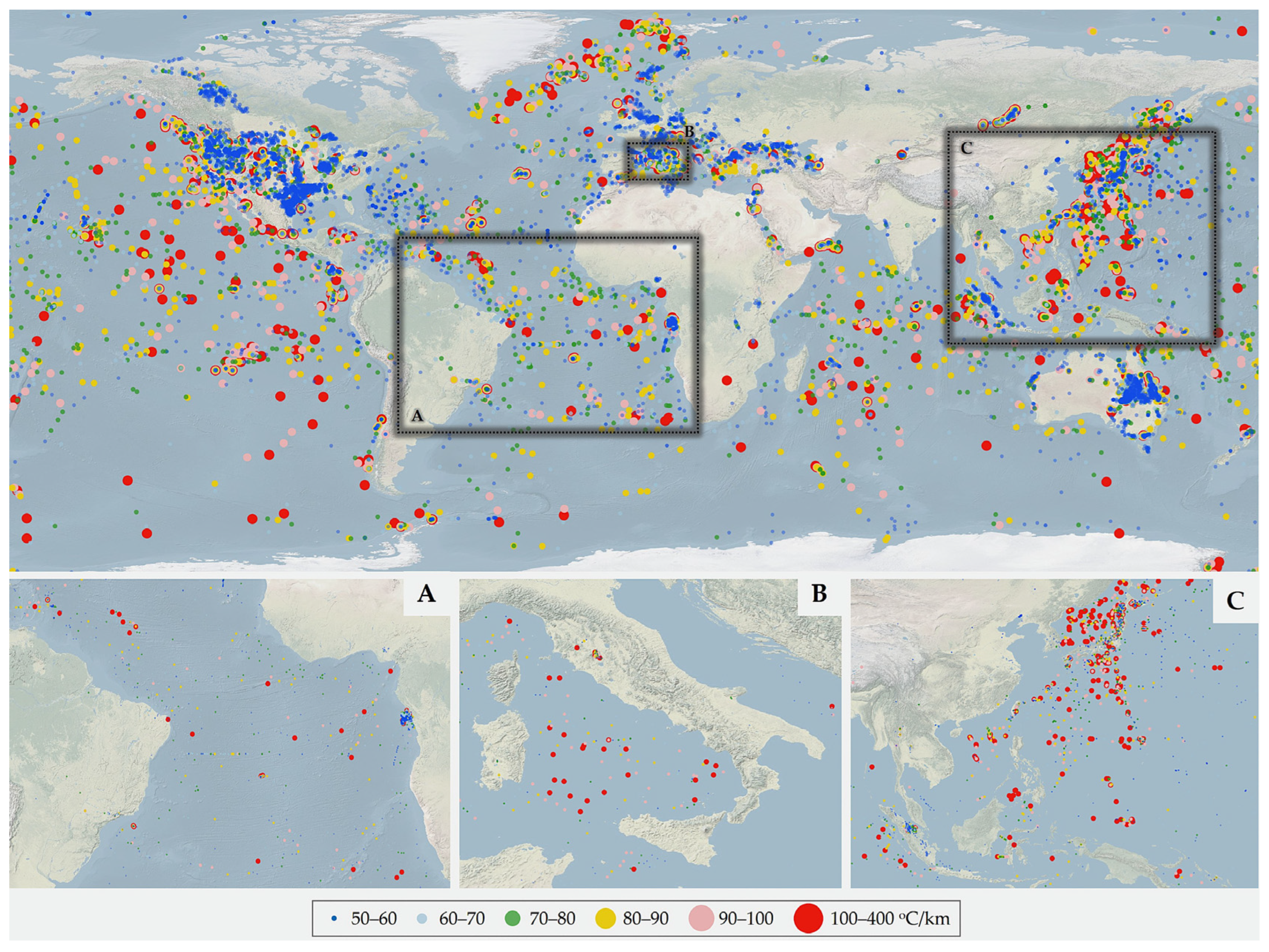
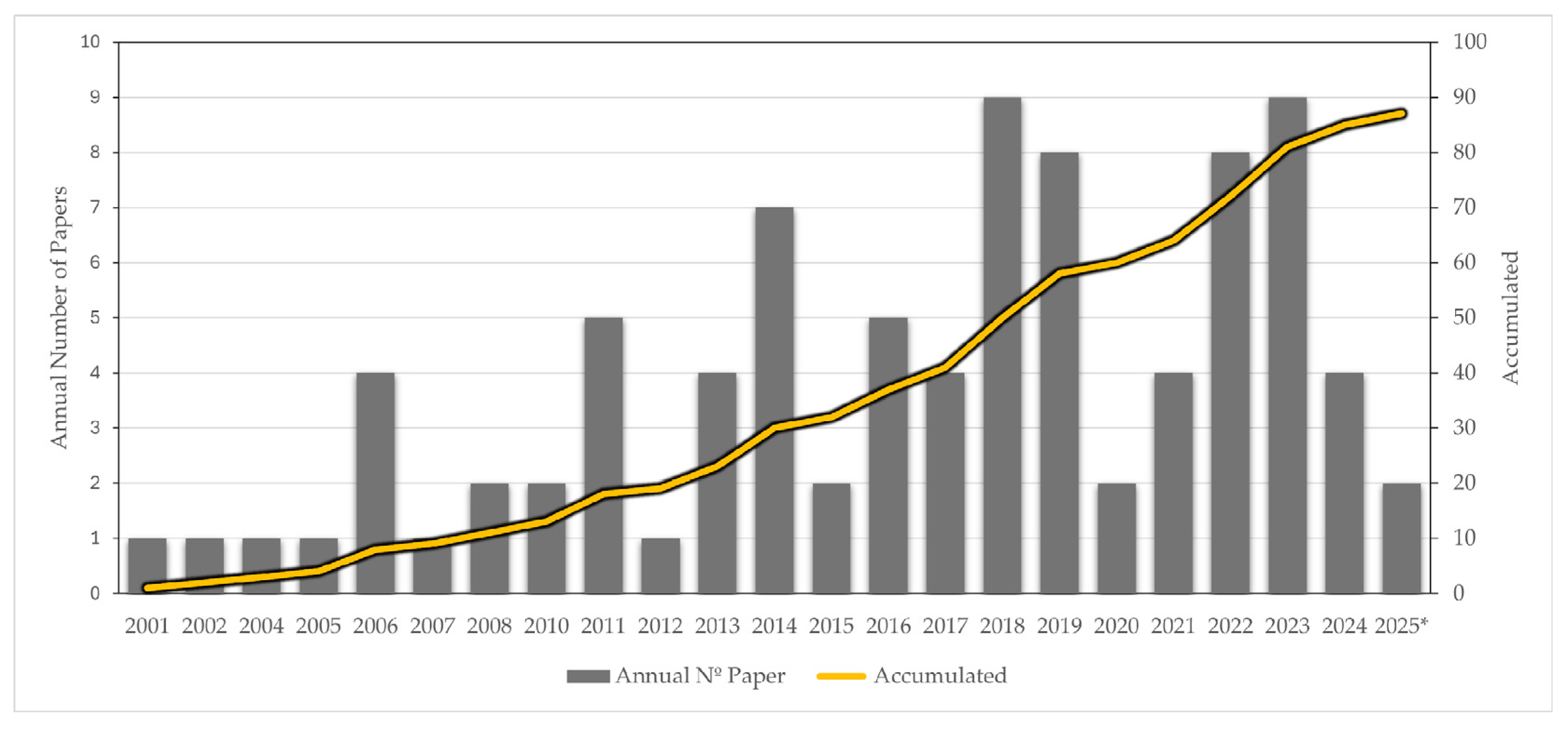

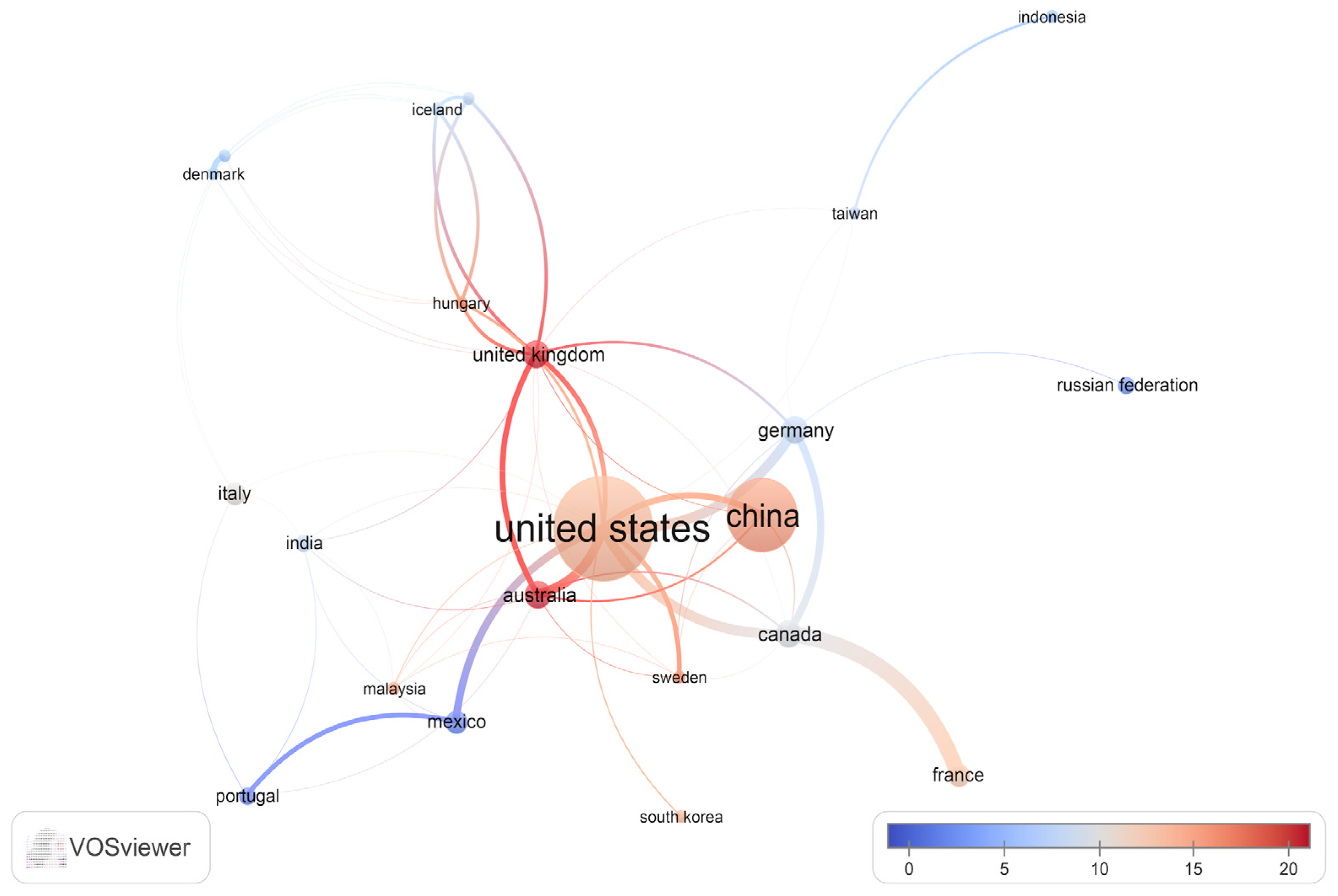
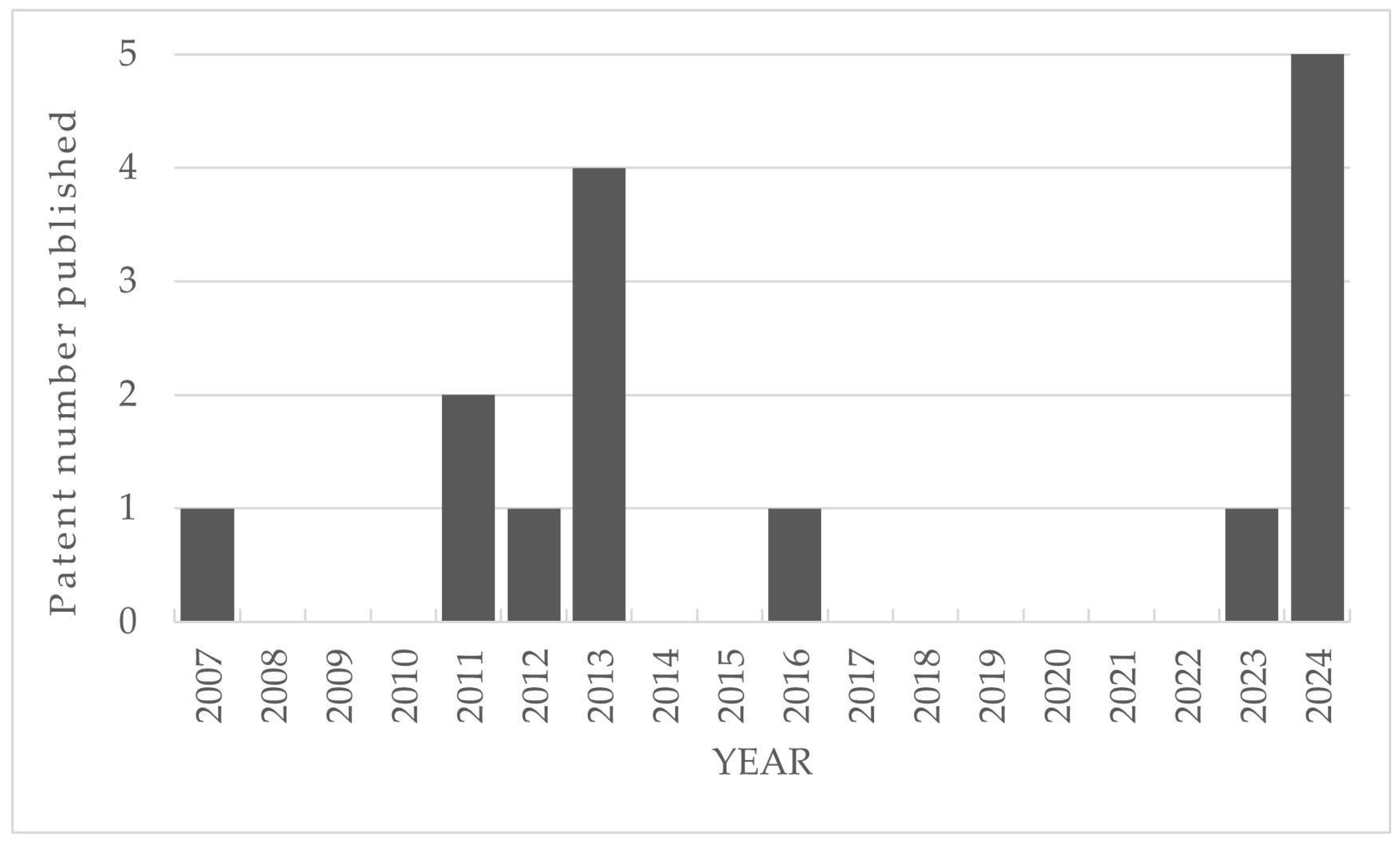


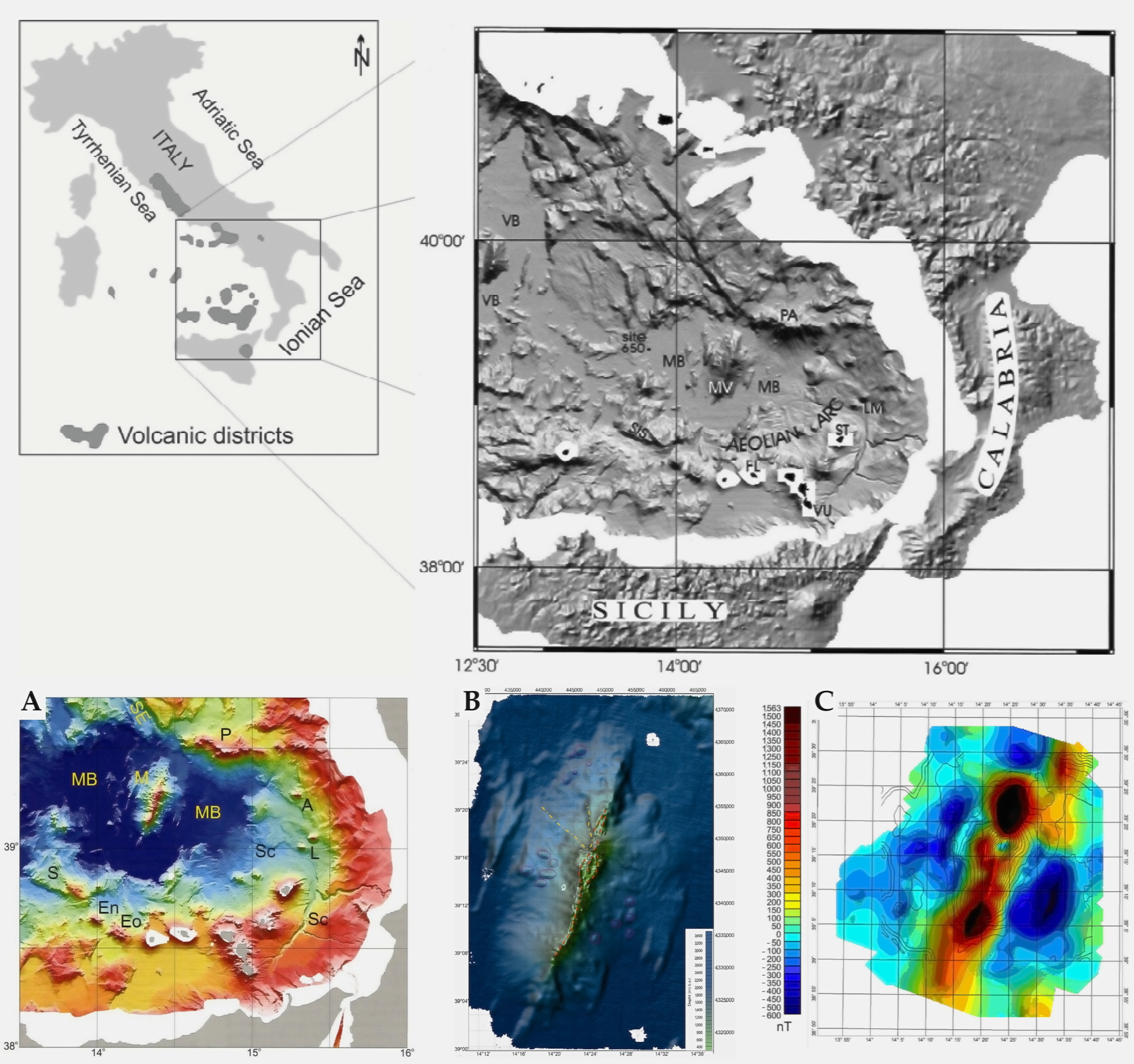
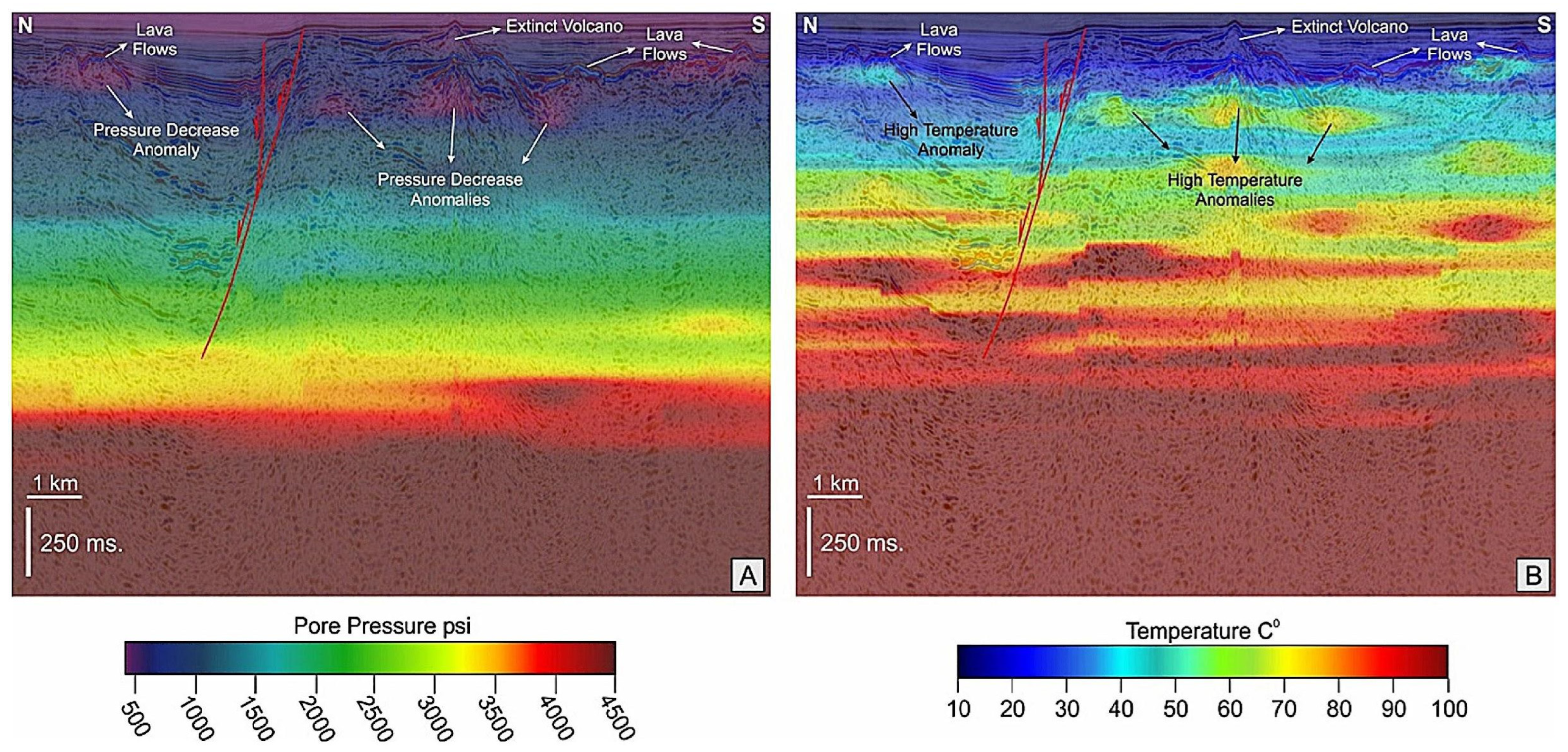
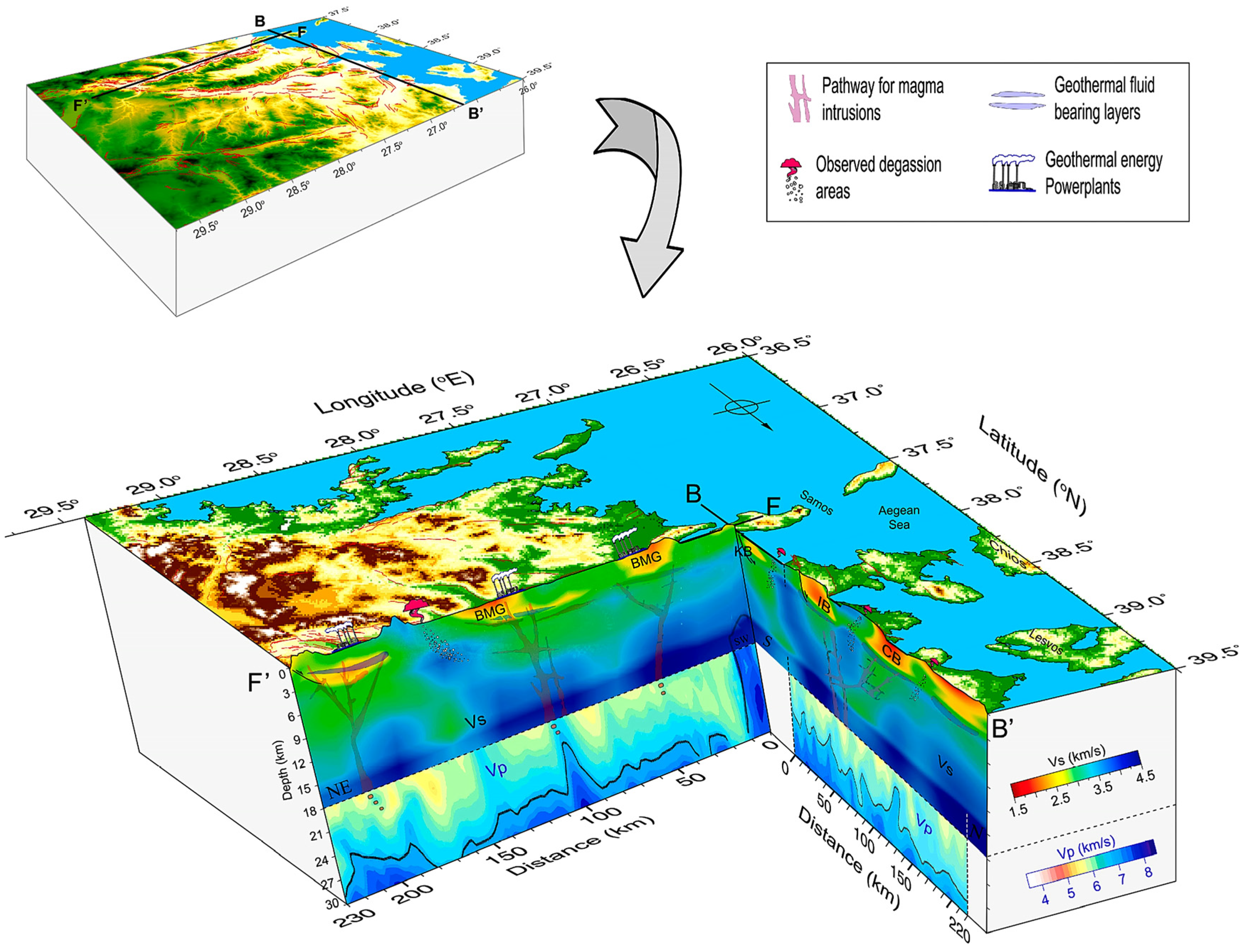
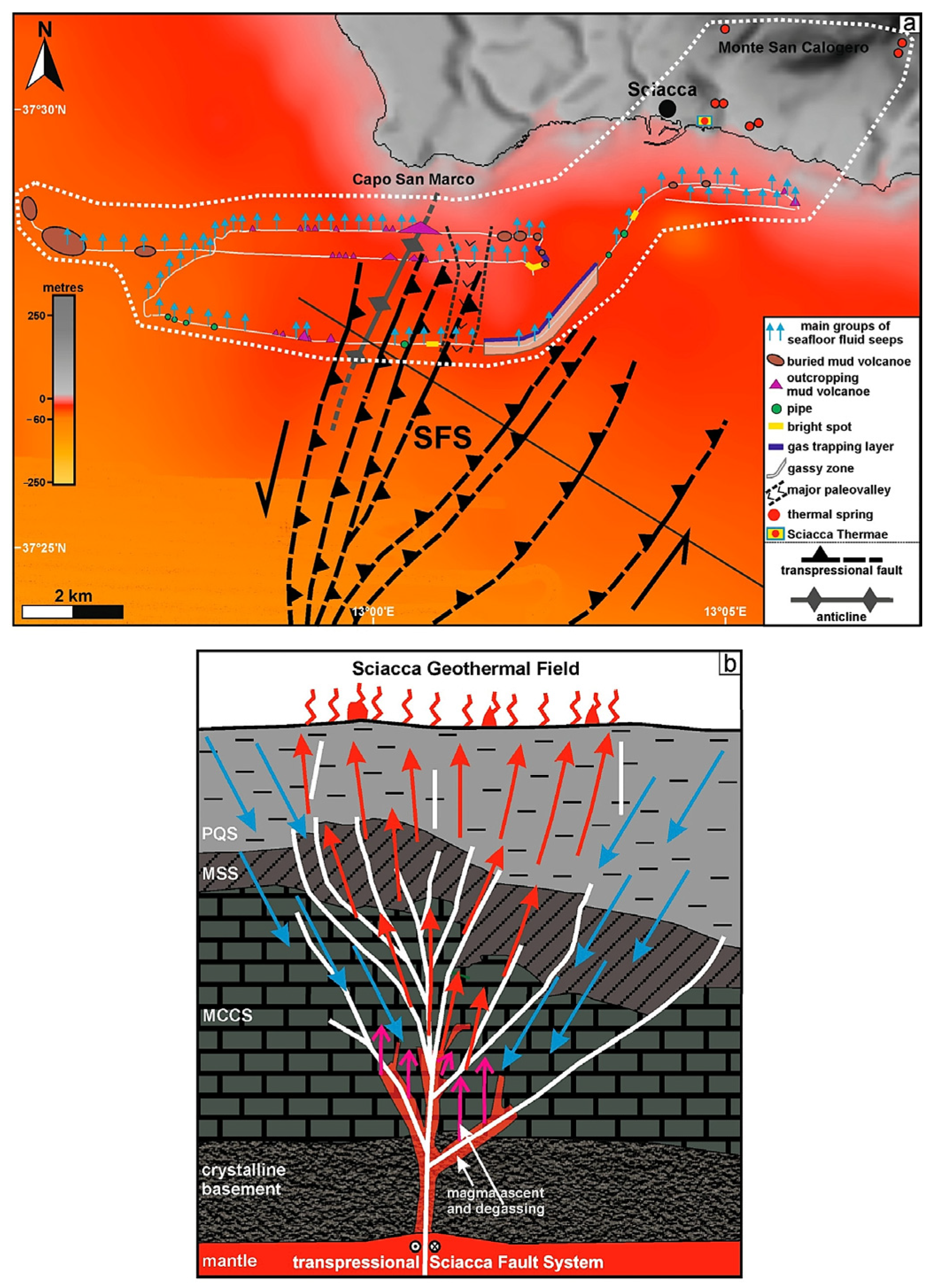

| S.Nº | Patent Title | Applicant | Country | Year Publication | Database |
|---|---|---|---|---|---|
| 1. | Marine Geothermal Exploration System | Guangzhou Marine Geol Survey | China | 2011 | EspaceNET |
| 2. | Deep Ocean Hydrothermal Sequence Sampler | Univ. Zhejiang | China | 2007 | EspaceNET |
| 3. | Device For Measuring Geothermal Amount Of Ocean | Korea Inst. Ocean. Sci. & Tech. | South Korea | 2016 | EspaceNET |
| 4. | Optimal Selection Method For Offshore Geothermal Resource Target Area | CNOOC 1 | China | 2024 | EspaceNET |
| 5. | Ocean Geothermal Power System Using Multi-Step Reheating Rankine Cycle | Korea Ocean Res. Dev. Inst. | South Korea | 2013 | EspaceNET |
| 6. | Marine Geothermal Power Generation System With Turbine Engines | Shifferaw Tessema Dosho | USA | 2013 | EspaceNET |
| 7. | Self-Powered Observation Apparatus Based On Submarine Hydrothermal Solution | Univ. Zhejiang | China | 2023 | EspaceNET |
| 8. | Ocean Thermal Energy And Geothermal Energy Combined Power Generating System | Univ. Jimei | China | 2012 | EspaceNET |
| 9. | Geothermal Power Generation System With Turbine Engines And Marine Gas Capture System | Shifferaw Tessema Dosho | USA | 2013 | EspaceNET |
| 10. | Geothermal Power Generation System With Turbine Engines And Marine Gas Capture System | Shifferaw Tessema Dosho | USA | 2013 | EspaceNET |
| 11. | Geothermal Energy And Wind Power Coupled Offshore Oil And Gas Platform Combined Power Generation System | CNOOC 1 | China | 2024 | EspaceNET |
| 12. | System To Extract Hydrothermal Energy From Deepwater Oceanic Sources And To Extract Resources From Ocean Bottom | Marshall Bruce | USA | 2011 | EspaceNET |
| 13. | Geothermal Power Systems And Methods For Subsea Systems | Schlumberger 2 | USA | 2024 | USPTO |
| 14. | Geothermal Power Systems And Methods For Subsea Systems | Schlumberger 2 | USA | 2024 | USPTO |
| 15. | Geothermal Plant For Extracting Energy From A Geothermal Reservoir Located Below The Ocean Bottom | CGG | USA | 2024 | USPTO |
Disclaimer/Publisher’s Note: The statements, opinions and data contained in all publications are solely those of the individual author(s) and contributor(s) and not of MDPI and/or the editor(s). MDPI and/or the editor(s) disclaim responsibility for any injury to people or property resulting from any ideas, methods, instructions or products referred to in the content. |
© 2025 by the authors. Licensee MDPI, Basel, Switzerland. This article is an open access article distributed under the terms and conditions of the Creative Commons Attribution (CC BY) license (https://creativecommons.org/licenses/by/4.0/).
Share and Cite
Souza, P.H.G.; Szklo, A. Offshore Geothermal Energy Perspectives: Hotspots and Challenges. Resources 2025, 14, 103. https://doi.org/10.3390/resources14070103
Souza PHG, Szklo A. Offshore Geothermal Energy Perspectives: Hotspots and Challenges. Resources. 2025; 14(7):103. https://doi.org/10.3390/resources14070103
Chicago/Turabian StyleSouza, Paulo H. Gulelmo, and Alexandre Szklo. 2025. "Offshore Geothermal Energy Perspectives: Hotspots and Challenges" Resources 14, no. 7: 103. https://doi.org/10.3390/resources14070103
APA StyleSouza, P. H. G., & Szklo, A. (2025). Offshore Geothermal Energy Perspectives: Hotspots and Challenges. Resources, 14(7), 103. https://doi.org/10.3390/resources14070103







